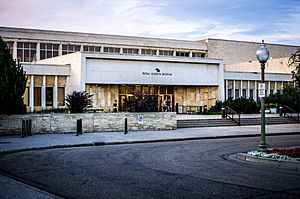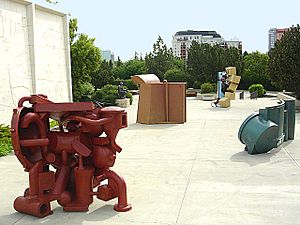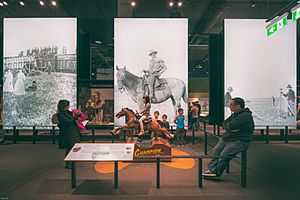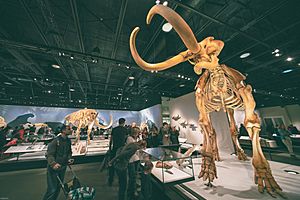Royal Alberta Museum facts for kids

Logo since 2018
|
|

The Royal Alberta Museum located in downtown Edmonton
|
|
| Lua error in Module:Location_map at line 420: attempt to index field 'wikibase' (a nil value). | |
| Former name | Provincial Museum of Alberta (1967-2005) |
|---|---|
| Established | December 6, 1967 |
| Location | Edmonton, Alberta, Canada |
| Type | Natural history, human history |
| Key holdings | Big Things 3 |
| Collections | Cultural studies, Earth science, life science |
| Collection size | >2,000,000 |
| Visitors | >400,000 (2018-19) |
| Architect | Raymond O. Harrison (1967) Ledcor, DIALOG (2017) |
| Owner | Government of Alberta |
| Public transit access | |
The Royal Alberta Museum (RAM) is a big museum in Downtown Edmonton, Alberta, Canada. It's located north of City Hall. This museum is the largest in western Canada. It has over 82,000 square feet (7,600 m2) of space for exhibits. The whole building is about 419,000 square feet (38,900 m2) in size.
The museum was started by the Government of Alberta in December 1967. Back then, it was called the Provincial Museum of Alberta. In 2005, Queen Elizabeth II gave it a special royal title. That's when it became the Royal Alberta Museum.
In 2011, plans were made to move the museum to a new building. The old museum in Glenora, Edmonton stayed open until December 2015. Even when it was closed to visitors, some teams kept working. They prepared the museum's huge collection for the move. Others continued their fieldwork outside the museum.
The new building was finished in August 2016. It officially opened to the public in October 2018. The museum has large galleries that show Alberta's nature and history. It also has a special gallery for traveling exhibits from all over the world. There's an interactive children's gallery, which is about 7,000 square feet (650 m2). Plus, there's a bug room with live insects and a nursery where you can see them grow.
Contents
History of the Museum
The Canadian Federal Government and the Government of Alberta started planning a museum in 1950. In 1962, they hired Raymond O. Harrison to lead the project. He was an architect from Australia. Harrison had helped design the Vancouver Maritime Museum. He was given $5 million to build the museum, hire staff, and collect items.

The museum first opened its doors on December 6, 1967. It was called the Provincial Museum of Alberta. On opening day, the main floor had exhibits about the fur trade. It also showed the history of Indigenous Peoples in Alberta. There were old photos of Aboriginal people by Ernest Brown and Harry Pollard.
The second floor had exhibits on farming and early pioneer life. It also showed industry and business. The museum grew a lot in the 1960s and 1970s. More exhibits, programs, and staff were added. In 1968, new exhibits about Alberta's dinosaurs were added. There was also a display called "Adaptations for Survival."
The human history section also got new exhibits. These included "Vehicles of Alberta's Past" and "Early Building in Saskatchewan." In 1969, exhibits on volcanoes and the thrush bird family were added. Displays about Indigenous peoples' history and farming tools were also added. That same year, a diorama (a 3D scene) of Pronghorns was created. It was the first of many displays showing Alberta's natural habitats.
In 1982, the provincial government made a big change. They separated the museum's palaeontology program. This included many staff and the fossil collection. This was done to help create the Royal Tyrrell Museum of Palaeontology. That museum opened in 1985.
In 1990, the museum started charging for admission. To attract more visitors, the ground floor Indian Gallery was removed. That space was then used for special temporary exhibits. In 1991, the mammal and bird gallery was updated. It got a new display called "Survival and Reproduction." The next year, the "Beauty and Science of Birds" exhibit was built. It included three new dioramas.
A temporary exhibit called "The Bug Room" was very popular in 1992. Because it was so successful, the museum made it a permanent part of the museum in 1993. A new "Earth Science Gallery" partly opened in December 1993. It was fully finished the next May. Also in 1993, the museum launched "In All Their Finery." This exhibit showed beautiful aboriginal artifacts. It was the first part of a larger exhibit.
The full "Syncrude Gallery of Aboriginal Culture" opened in November 1997. This gallery later got a huge addition. The museum bought many items from the family of James Carnegie, 9th Earl of Southesk. This happened at a Sotheby's auction in 2006. The sale was called the most important auction of North American Indian artifacts ever. It included a special beaded dress from 1859. It cost US$497,600.

In 2003, the Habitat Gallery was greatly updated. It became the new "Wild Alberta" interactive exhibit. From 2002 to 2006, the Royal Alberta Museum hosted the "Big Things" outdoor sculpture exhibition. These large sculptures were displayed on the South Terrace.
In 2005, Alberta celebrated its 100th birthday. The NESW created a special sculpture exhibition for the museum. On May 24, 2005, Queen Elizabeth II visited the museum. She gave it the special royal title. On December 6, 2015, the museum closed its doors. It had been open for 48 years and was moving to a new place.
The New Building
In April 2011, it was announced that a new Royal Alberta Museum would be built. It would be in Downtown Edmonton, north of the city hall. The new building is 36,000 square meters (390,000 sq ft). It has twice as much gallery space as the old one. The cost was estimated at $340 million. The building was completed in 2016.
Construction of the new building finished on August 16, 2016. The opening date of October 3, 2018, was announced later. The new museum is the biggest in western Canada. It has over 82,000 square feet (7,600 m2) of exhibit space. The total size is over 419,000 square feet (38,900 m2).
The museum has huge galleries that tell the stories of Alberta's nature and culture. There's a special gallery for traveling exhibits from around the world. It also has an interactive children's gallery. This space is about 7,000 square feet (650 m2). There's also a bigger bug room with live insects and a nursery. The total cost for the new building and the move was about CAD $375.5 million. The Government of Alberta paid $253 million. The federal government helped with $122.5 million.
Museum Collections
The museum has a huge collection of over 2 million objects! These items are grouped into four main types:
- Life Science: This includes plants, fish, reptiles, insects, mammals, and birds. There are 577,745 objects in this collection.
- Earth Science: This section has items about archaeology, geology, and ancient animals. It includes fossils from the Ice Age. There are 9,224,075 objects here.
- Human History: This collection covers the history of people. It includes items from different cultures, military history, and Western Canadian history. There are 137,610 objects.
- Collections Services: This group manages all the collections. It includes conservation (taking care of items) and the museum's library. There are 70,103 objects in this area.
Between 1989 and 2001, the museum hosted 175 traveling exhibits. Some popular ones included: Prehistorics Gigantics (1990), Whales! Bigger than Dinosaurs (1992), and Sharks: Facts and Fantasy (1993). Other exhibits were Masters of the Night: The True Story of Bats (1994) and Carnosaurs! (1995). There was also Bugsworld (1996) and Genghis Khan (1997).
Museum Galleries
Here are the main galleries you can explore at the Royal Alberta Museum today:
- Natural History Hall: This hall shows Alberta's wildlife. It has dioramas, fossils, animals, and plants.
- Ice Age Alberta: Learn about plants and animals from 10,000 years ago.
- Ancient Alberta: Discover Alberta's Rocky Mountains and different rocks. See an Edmontosaurus!
- Gems and Minerals: Explore meteorites, crystals, and colorful minerals. See rubies, diamonds, and emeralds from Canada and around the world.
- Wild Alberta: Find out about animals and plants in Alberta's three main natural areas. See the wild landscapes.

- Human History Hall: This hall tells the story of Alberta's past and its people.
- Ancestral Lands: Learn about the history and lives of Indigenous people in Alberta.
- Worlds Meet: See how Indigenous people and European newcomers shared cultures and traded from 1680 to 1880.
- After Buffalo: Hear stories from 1859 to 1900 about challenges and hope in Alberta.
- Alberta Forms: Discover how Alberta became a province in the 1880s. Learn about its economy, culture, and beliefs.
- Alberta Transforms: Explore stories from Alberta after 1945. Learn about oil, population growth, and changes in healthcare and equal rights.
- What Makes Us Strong: Share in the knowledge and values of Alberta's many Indigenous communities.
- Bug Gallery: This gallery shows insects, spiders, and other invertebrates. They come from Alberta and all over the world. You can learn about:
- What an invertebrate is.
- How insects change (Metamorphosis).
- How predators hunt (Ambush predators).
- How insects find a mate.
- Protecting coral reefs (Reef Conservation).
- Insects that live in groups (Social Insects).
- Animals with bright warning colors.
- The many different creatures in freshwater.
- Children's Gallery: This gallery is a fun place for younger visitors to play and learn. It has sections like:
- Alberta Naturally.
- A Dig Pit.
- A Toddler Area.
- Chautauqua.
- A Makerspace.
- A Community Gallery.
- Feature Gallery: This gallery shows special exhibits for a limited time.
- Changing Exhibition: This gallery lets visitors explore different parts of Alberta's history and current stories.
Past Galleries
When the Royal Alberta Museum was in Glenora, it had these galleries:
- Wild Alberta Gallery: This gallery had dioramas showing Alberta animals in their natural homes. It also taught about Alberta's ecosystems.
- Syncrude Gallery of Aboriginal Culture: This gallery explored the history of North American Aboriginals. It had over 3,000 artifacts from 11,000 years of history.
- Natural History Gallery: This gallery was home to the popular "Bug Room." It also had areas about Alberta's plants and birds. The entrance had a large geology exhibit with gems and rocks.
See also
- List of Canadian organizations with royal patronage
- List of museums in Alberta




